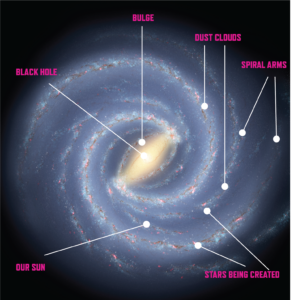Recreate the Milky Way galaxy with dough!

This activity is best suited to students in primary school. It requires an ability to follow instructions in order for around 30 minutes. It’s a great option for students that like tactile activities. You can encourage creativity in participants by allowing participants to choose their own colours and, after the Milky Way is complete, the addition of dough creations that fit the theme – UFO’s and comets, while they may not make sense for the scale being created, are a good way to have participants remain engaged.
THE SCIENCE
To take a photo of our entire galaxy, the Milky Way, we would need to send a camera on a journey that would take 35 billion years. This journey would take it through our galaxy, and beyond, far enough to look back and see all of its stars. As we don’t have quite that much time, astronomers study nearby galaxies that we believe look similar to our own.
Even though we don’t have a picture of the Milky Way, we know that it is a spiral galaxy. In the middle of every large galaxy, including ours, is a supermassive black hole. Astronomers don’t yet know which formed first: the black holes, or the galaxies around them. ASTRO 3D astronomers studied galaxies to find out the answer.
Surrounding the black hole is the galactic bulge, which in the Milky Way, is very bright. This is because the bulge is full of old stars so it looks yellow and puffy.
Spiral galaxies have beautiful spiral arms spreading out from the bulge. In these arms are younger, bluer, hotter stars. There are also clouds of dust and gas that look dark to our eyes. In places where these clouds get very hot and collapse, new stars are born.

THE ACTIVITY
- Lay your ‘Make a galaxy here’ sheet of paper on a table.
- Ensure you have the black, yellow, blue, brown and red playdough.
- To make a supermassive black hole roll a small circle of black dough in your hands. Place it in the centre of your galaxy.
- Make a small, fat sausage (about the size of an eraser) using yellow dough. Place it entirely over the black hole to create the galactic bulge. Make sure it bulges out from the page!
- Roll out two thin blue sausages (the size and width of a pencil) and spiral them around the galactic bulge, squashing them down, to create your spiral arms.
- Roll out two even skinnier sausages in brown and lay them down the centre of each of your spiral arms, squashing them down, as the molecular clouds.
- Take tiny pieces of red dough and squash them along the molecular clouds as places where stars are being created.
- Make a tiny star shape in yellow dough and squash it in a spiral arm near the edge – this is our Sun!
CURRICULUM LINKS
AUSTRALIAN CURRICULUM V9 | SCIENCE | Science Understanding
Foundation
Represent observations in provided templates and identify patterns with guidance (AC9SF103)
Year 2
– exploring representations of the solar system and identifying Earth and other planets
– creating a class model of the solar system and naming the sun and planets
– recognise Earth is a planet in the solar system and identify patterns in the changing position of the sun, moon, planets and stars in the sky
Recognise that materials can be changed physically without changing their material composition and explore the effect of different actions on materials including bending, twisting, stretching and breaking into smaller pieces (AC9S2U03)
Year 6
Describe the movement of Earth and other planets relative to the sun and model how Earth’s tilt, rotation on its axis and revolution around the sun relate to cyclic observable phenomena, including variable day and night length (AC9S6U02)
– exploring simulations of the solar system such as a pocket solar system to appreciate the distances and relationships between the sun and planets